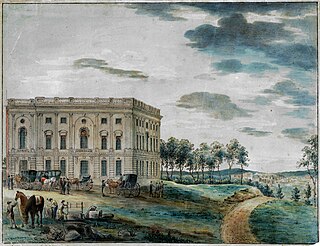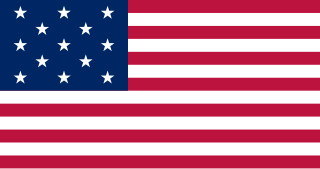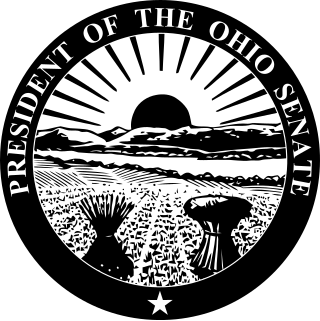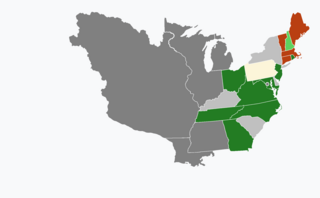
The 7th United States Congress was a meeting of the legislative branch of the United States federal government, consisting of the United States Senate and the United States House of Representatives. It met in Washington, D.C. from March 4, 1801, to March 4, 1803, during the first two years of Thomas Jefferson's presidency. The apportionment of seats in the House of Representatives was based on the 1790 United States census. Both chambers had a Democratic-Republican majority, except when the Senate held a two-day Special Senate session in order to provide advice to the new President Thomas Jefferson, when there was still a Federalist majority in the Senate.

The Northwest Territory, also known as the Old Northwest and formally known as the Territory Northwest of the River Ohio, was formed from unorganized western territory of the United States after the American Revolution. Established in 1787 by the Congress of the Confederation through the Northwest Ordinance, it was the nation's first post-colonial organized incorporated territory.

Ross Township is one of thirteen townships in Butler County, Ohio, United States. It is located in the south-central part of the county, southwest of the city of Hamilton. The population was 8,736 at the 2020 census.
The redistricting of United States congressional districts is made by the legislatures of the states every 10 years, immediately following the official announcement of the federal census that serves as the basis of the apportionment. It was long the practice that the apportionment thus made stood until after the next decennial census.

William Creighton Jr. was the 1st Secretary of State of Ohio, a United States representative from Ohio and a United States district judge of the United States District Court for the District of Ohio.
Joseph Cable was an American lawyer and politician who served as a U.S. Representative from Ohio for two terms from 1849 to 1853. He was the great-grandfather of Congressman John Levi Cable.

The Enabling Act of 1802 was passed on April 30, 1802, by the Seventh Congress of the United States. This act authorized the residents of the eastern portion of the Northwest Territory to form the state of Ohio and join the U.S. on an equal footing with the other states. In doing so it also established the precedent and procedures for creation of future states in the western territories.

Joseph Darlinton was an American politician in the U.S. state of Ohio and in the Northwest Territory prior to Ohio statehood. Darlinton represented Adams County as a member of the Northwest Territory House of Representatives and the Ohio Senate. Darlinton also served as a delegate to the convention that drafted the first state constitution for Ohio.

Abraham Shepherd (1776–1847) was a politician from Ohio, United States who was a leader of both houses of the Ohio General Assembly early in the 19th century.
Thomas Quin Ashburn was an American judge on the Supreme Court Commission of Ohio from 1876 to 1879, and a member of the Ohio State Senate for twelve days at the end of his life in 1890.
William Goforth (1731–1807), also called Judge William Goforth and Major William Goforth, was a member of the Committee of One Hundred and Committee of Safety in New York City, an officer of the New York Line during the American Revolutionary War, and was a member of the New York State Assembly after the war. He was one of the earliest immigrants to the Cincinnati area, where he was named a judge and was elected to the territorial legislature.

The Second Ohio General Assembly was the second meeting of the Ohio state legislature, composed of the Ohio State Senate and the Ohio House of Representatives. It convened in Chillicothe, Ohio, on December 5, 1803, and adjourned February 17, 1804. This General Assembly coincided with the second year of Edward Tiffin's first term as Ohio Governor.
John Bigger was a politician in the early history of the U.S. state of Ohio. He served eight terms in the Ohio House of Representatives and thirteen in the Ohio State Senate, including one term as Speaker of the House.
Since the OHSAA began basketball competition in 1922–23, many schools have decided to band together in conferences to help scheduling, added competition for titles and bragging rights, and oftentimes help determine seeding for the early rounds of the state tournament. Some conferences had been established for football-playing schools, and as schools added other sports, adopted those under the conference banner once enough schools started playing. Smaller schools often picked up basketball first, adding other sports later, and combined with other in-county schools to form County conferences. Most of these leagues were formed in the 1920s and early 1930s after the tournament was started, which is why quite a few lack a definitive starting date at this point in time.

United States gubernatorial elections were held in 1805, in 13 states.

The Third Ohio General Assembly was the third meeting of the Ohio state legislature, composed of the Ohio State Senate and the Ohio House of Representatives. It convened in Chillicothe, Ohio, on December 3, 1804, and adjourned February 22, 1805. This General Assembly coincided with the last year of Edward Tiffin's first term as Ohio Governor.

The Fourth Ohio General Assembly was the fourth meeting of the Ohio state legislature, composed of the Ohio State Senate and the Ohio House of Representatives. It convened in Chillicothe, Ohio, on December 2, 1805, and adjourned January 27, 1806. This General Assembly coincided with the first year of Edward Tiffin's second and final term as Ohio Governor.

The Fifth Ohio General Assembly was the fifth meeting of the Ohio state legislature, composed of the Ohio State Senate and the Ohio House of Representatives. It convened in Chillicothe, Ohio, on December 1, 1806, and adjourned February 4, 1807. This General Assembly coincided with the second year of Edward Tiffin's final term as Ohio Governor.

The Sixth Ohio General Assembly was the sixth meeting of the Ohio state legislature, composed of the Ohio State Senate and the Ohio House of Representatives. It convened in Chillicothe, Ohio, on December 7, 1807, and adjourned February 22, 1808.









